 When,
in the mid-eighteenth century, Linnaeus was setting out the method of nomenclature
that we use yet today to identify animals by genera and species, he was
puzzled by the variety of human beings. There were, it was reported, people
with tails (Homo caudatus), the apes collected in his employer's
garden (Homo simia), mankind who lived in the dark (troglodyte),
humankind who called siren-like (Homo marinus) --- even human children
reared by wild creatures. These he chose to characterize as members of
the species ferus.
When,
in the mid-eighteenth century, Linnaeus was setting out the method of nomenclature
that we use yet today to identify animals by genera and species, he was
puzzled by the variety of human beings. There were, it was reported, people
with tails (Homo caudatus), the apes collected in his employer's
garden (Homo simia), mankind who lived in the dark (troglodyte),
humankind who called siren-like (Homo marinus) --- even human children
reared by wild creatures. These he chose to characterize as members of
the species ferus.
He knew of ten such children from the literature then available. Today
we can count studies of over 400 reported feral children, and these are
not to be confused with children so raised and made prominent in fiction
nor those merely isolated and confined by human captors. The reports you
are seeing are concerned with re-presenting these literary inventions by
recapturing the largely 19th century European literature that hatched,
in our times, the remarkable life of Tarzan.
"Fact, fiction or legend?" asks RudolphAltrocchi
in his clever, entertaining, and sophisticated history of the "ancestors
of Tarzan" published in 1944 and still an engaging read. Let us go forward
a little in time, say taking the number of years between Linnaeus's time
and our own and adding this to the present date. It is now, in our imagination,
2227 or so. There remain on our planet only a few libraries (this following
the great book burning and internet deconstruction in 2200) and the libraries'
books contain no information as to the former classifications: nonfiction,
fiction, reference --- these once useful designations are lost to us.
Readers of our imagined 23rd century cannot know whether the Tarzan books
are novels or authentic reports.
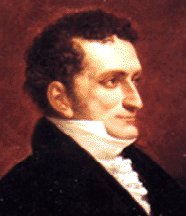 We may also find
in our surviving library Itard's two volumes describing his work with Victor,
the Wild Boy of Aveyron (1800); or the Reverend Singh's attempts to discover
whether the human mind naturally knows God, his aim in capturing and rearing
in the early 1920s Amala and Kamala, known as the ‘wolf-girls’. Fact,
of course, for these people surely existed. Fiction, of course,
because the observers provided a narrative, one necessarily of their choosing:
legend, surely, for when Itard took up work with Victor, a play about a
feral child was already on the Paris stage, and Rousseau's romantic notions
of nature were in the air. Legend? A visit to any village in India
will reveal a story about local wolf-children.
We may also find
in our surviving library Itard's two volumes describing his work with Victor,
the Wild Boy of Aveyron (1800); or the Reverend Singh's attempts to discover
whether the human mind naturally knows God, his aim in capturing and rearing
in the early 1920s Amala and Kamala, known as the ‘wolf-girls’. Fact,
of course, for these people surely existed. Fiction, of course,
because the observers provided a narrative, one necessarily of their choosing:
legend, surely, for when Itard took up work with Victor, a play about a
feral child was already on the Paris stage, and Rousseau's romantic notions
of nature were in the air. Legend? A visit to any village in India
will reveal a story about local wolf-children.
The wolf-children were undoubtedly alive and in that limited sense,
they are 'fact', but that does not make the description of them so. The
Reverend Singh took to his study each evening after dinner to write the
day's events with the girls, but these he knew from the account of his
wife and the helpers in the orphanage. Mrs. Singh dealt with the girls’
cultivation, focusing, understandably on toilet training and matters of
cleanliness. Reverend Singh's diary and accounts came into the hands of
Professor R. M. Zingg, who published them in 1939 along with selections
from Itard's reports on Victor coupled with accounts of Kaspar Hauser,
isolated as an infant, offered teaching and family, then murdered. Zingg
included photographs of the wolf girls made by the Singhs with their Brownie.
camera. (It appears that an additional 90 or so photos existed which were
made into 'lantern' slides: after Zingg's death these were moved from Denver
to Albuquerque, then to an unknown place.) Perhaps they are to be rediscovered.
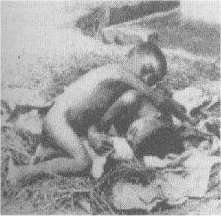 From
existing photographs of the wolf girls and Singh’s account, we can see
that the girls ran skillfully on all fours, killed and ate birds. Singh
thought that the girls learned some Hindi; others thought not. Were the
girls' skills constrained by their lack of human culture, by their being
reared by wolves (assuming that Singh was not merely duped, which seems
the more likely fact) or by organically-caused limited ability to acquire
new habits, skills, and understandings? Tarzan's learned skills and
linguistic abilities were not so hampered. He readily and greedily learned
at least two European languages (plus ape-talk), but curiously showed no
great mathematical ability. It is curious that teachers of these children
and of apes think language to be of primary importance, for language is
the most ambiguous of skills. Researchers rarely examine the most culture-free
of abilities; namely, arithmetic.
From
existing photographs of the wolf girls and Singh’s account, we can see
that the girls ran skillfully on all fours, killed and ate birds. Singh
thought that the girls learned some Hindi; others thought not. Were the
girls' skills constrained by their lack of human culture, by their being
reared by wolves (assuming that Singh was not merely duped, which seems
the more likely fact) or by organically-caused limited ability to acquire
new habits, skills, and understandings? Tarzan's learned skills and
linguistic abilities were not so hampered. He readily and greedily learned
at least two European languages (plus ape-talk), but curiously showed no
great mathematical ability. It is curious that teachers of these children
and of apes think language to be of primary importance, for language is
the most ambiguous of skills. Researchers rarely examine the most culture-free
of abilities; namely, arithmetic.
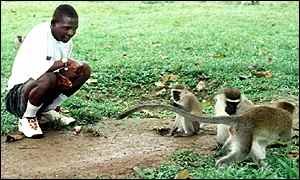
John Ssebunya, the Ugandan Monkey Boy
I have first-hand knowledge of two living feral children, John,
the monkey-boy of Uganda and CauCau
of Chile. Both have common backgrounds and narratives: alcoholic and
quarrelsome parents, the child leaves home, taking to the neighbors’ garbage,
then to the streets, then the 'forest', more scrub than dense; some time
away from human civilization in this 'forest', and kind families who provide
structure and education. In John's case, he was supported (he says) by
monkeys. Now 17, he has this narrative well in mind. I assume the monkeys
to be vervets because this common African monkey toss away half the food
they examine and would allow a nonaggressive human to hang around the periphery
of their active troops. As a cautionary lesson, I tell you this: when I
asked John his relationship with the monkeys, the translator reported him
to say "They fed me." When I asked him to show me how, he got down on all
fours and grabbed the air as if food was flying through it, exactly what
I would have expected from vervets tossing their food about. The
sentence "They fed me." is equivocal: the lesson is how easy it is for
the observer to re-interpret the meaning intended.
John is being educated in an English-speaking school and he has been
there for perhaps ten years. My impression is that while he does not speak
this or another language readily, he understands more than is apparent.
John's story is a relatively happy one: adopted by foster parents who have
raised many other children, offered an education, he is having an
active and life. He is now acclimated to television performance.
'Feral" does not describe him in either the Latin or English meaning and,
if one thinks that examination of abandoned children illustrates the contrasting
effects of nature and nurture, his being comes down firmly on the side
of nurture, all credit to his family.
CauCau, too, now in his 70s, now has a relatively happy life. Captured
when he was perhaps 12, he spent time in a place variously described as
a mental institution or a charity hospital. Two years later, he was transferred
and raised by his foster-mother, Berta Riquelme, a specialist in linguist
education. He has learned to speak (or, perhaps, re-learned), he cares
for himself, although members of his extended family from time to time
protect him from intrigued members of various media. Both John and CauCau
rank as adults with 'problematic childhoods,' but surely they fall within
the wide range called 'normal'. We may attribute their success to kind
individuals who composed family, or we may decide that the abandonment
had little effect; perhaps both are true. Their lives and those of Tarzan
follow a now familiar narrative.
The presentation you now examine is an incunabula, the Latin word for
a hatchery. The issue of how the ideas for Tarzan were hatched have been
well explored. They vary from the assertion that Tarzan's creator knew
some ancient Greek and was influenced by his high school reading of Homer
(evidence is presented that Burroughs used ancient Greek syntax more frequently
than one would suppose) to Burroughs’s own assertion that he had no idea
of any sources, but might have been influenced by hearing or reading a
tale of a shipwrecked sailor.
The essential elements of Tarzan are so powerfully attractive to the
human mind that they appear, and reappear, in both fiction and putative
scientific fact. Such is the evidence of the power of the wish to separate
the effect of civilization from humankind’s ‘natural’ (not to say
‘unnatural’ or uncivilized state). Fiction, after all, is only a term for
a literary convention, not a statement of unreality: fiction is yet another
expression of the surely nonfictional human mind tries to understand the
worlds it perceives.
Three clearly nonfictional people come to mind, all of whom were in
fact removed from their natural state to that of western ideas of civilization.
Like Tarzan, to western eyes, they were transfigured from a natural state
to living in society and civilization. Each lived at the time of Burroughs’s
youth. There is no evidence that he knew of them, and it would be immaterial
if he did.
I speak of Ota Benga, whose later life was spent in the New York Zoological
Society, the Bronx Zoo; of Minik, an Eskimo from Lapland procured by Admiral
Peary and deposited with the American Museum of Natural History, and Ishi,
last of his tribe, found in Oroville, California, and resident of the Anthropological
Museum, then in San Francisco.
 Born in 1881 (?),
captured, enslaved, or liberated; kidnapped or a willing adventurer ---
your choice --- in the Congo (but a Bushman) somewhere between 1892 and
1904, some say Ota Benga was recruited willingly to be displayed at the
Chicago
Fair of 1893. The fair featured examples of cultures (and their proposed
degree of evolution) with group settings in which the representatives lived
for the duration of the fair. We can guess that his presence fit the notion
of the evolution of humankind then evident not merely in the newspapers,
but in the thought of senior scientists
Born in 1881 (?),
captured, enslaved, or liberated; kidnapped or a willing adventurer ---
your choice --- in the Congo (but a Bushman) somewhere between 1892 and
1904, some say Ota Benga was recruited willingly to be displayed at the
Chicago
Fair of 1893. The fair featured examples of cultures (and their proposed
degree of evolution) with group settings in which the representatives lived
for the duration of the fair. We can guess that his presence fit the notion
of the evolution of humankind then evident not merely in the newspapers,
but in the thought of senior scientists
After, Ota Benga lived at the Bronx zoo where --- again, your choice
--- he was either displayed or had a job. We know that Ota Benga appeared
at the 1904 St Louis World’s Fair, as well as before the New York Explorers’
Club. We also know that he tired of being chased around the zoo and poked
at, so he wore a white suit while performing his duties. He expressed his
view of his position by chasing zoo visitors with a knife, thereby ending
his zoological value. We know that people of sympathy tried to provide
a theological education, but that Ota Benga preferred farming. We also
know that he shot himself and died in 1916. Of Ota Benga’s reactions to
New York civilization we know little more, certainly nothing first-hand.
Of Minik we know much more.
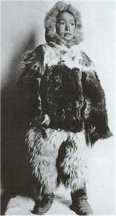 One of six Eskimo
removed from Lapland by the US Admiral Peary in 1897 for transfer to New
York, at the request of a newspaper and American Museum of Natural History,
he was one of two to survive the stay within the museum. (The other, older
man, returned home within the year.) Peary referred to Eskimos as
‘animals with speech’, a curious assessment from a man who fathered two
children by an Eskimo woman. Minik was perhaps seven years-old at the onset
of his stay. Befriended by a museum administrator named (William)
Wallace and his wife, a surname Minik took along with the middle name of
Peary, Minik was reared for a time in their home where he was educated
in western ways and was a companion to their son, Willie. As a young adult,
Minik moved about, living for a time in a hotel on West 44th Street in
Manhattan, returning to Lapland, marrying, not happily, and returning
to New York. Upon his return to Lapland (Peary dropped him 800 miles from
home), Minik could no longer be understood when speaking his native dialect.
One of six Eskimo
removed from Lapland by the US Admiral Peary in 1897 for transfer to New
York, at the request of a newspaper and American Museum of Natural History,
he was one of two to survive the stay within the museum. (The other, older
man, returned home within the year.) Peary referred to Eskimos as
‘animals with speech’, a curious assessment from a man who fathered two
children by an Eskimo woman. Minik was perhaps seven years-old at the onset
of his stay. Befriended by a museum administrator named (William)
Wallace and his wife, a surname Minik took along with the middle name of
Peary, Minik was reared for a time in their home where he was educated
in western ways and was a companion to their son, Willie. As a young adult,
Minik moved about, living for a time in a hotel on West 44th Street in
Manhattan, returning to Lapland, marrying, not happily, and returning
to New York. Upon his return to Lapland (Peary dropped him 800 miles from
home), Minik could no longer be understood when speaking his native dialect.
Minik had the advantage of schooling and some training in a college
of engineering. He charmed folk when a child, but in later adulthood attracting
widely different assessments of his personality. Always a nonwhite to New
Yorkers; yet a confused Eskimo to his perhaps envious village-mates, the
former treating him, however kindly at times, as a pet, the latter as a
confused teller of tall-tales about New York, allows us to put away the
idea that a change of culture carries with it no baggage.
What white Tarzan and Eskimo share is the idea that the orphan raised
without culture becomes a stronger figure for the experience. Kenn
Harper, whose sharp and brilliant book on Minik, pieces together the detail
of Minik’s life and those who interacted with him, tells us that "The theme
of the neglected orphan, mistreated by his own people and abandoned to
find his food among the scraps left by the dogs, is a common one in Eskimo
mythology. In these myths, the orphan invariably survives and grows into
adulthood to become a mighty hunter who ultimately wrecks his vengeance
on those who had most badly mistreated him." (p. 161) One might consider
that theme to be Tarzanic.
Minik applied for US citizenship in 1916, verifying, as required, that
he was not a believer in anarchism or polygamy. But neither citizenship
nor vengeance was to be his. He died in 1918, probably of influenza, and
is buried in New Hampshire.
Among the other Eskimo who did not survive the New York experience was
Minik’s father. When an adult, Minik would complain to the frisson of New
York newspapers that he had been deceived. Taken as a child to a
ceremony he believed to be his father’s burial, he later found his father’s
bones displayed in the museum. Of Minik’s other reaction to western civilization
we know little, although among his sympathetic observers was the anthropologist
Alfred Kroeber, who was destined to be Ishi’s companion in San Francisco
and Berkeley.
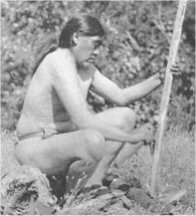 Ishi, a truly native
Californian, appeared in Oroville in 1911 indicating that he was the last
of his tribe. His language approximated that of another tribal language,
one understood to some degree by a Caucasian interpreter. Ishi explained
that all other members of his tribe known to him were dead, some killed
by ‘whites’. Taken to the Museum of Anthropology, then in San Francisco,
now on the Berkeley campus of the University of California, Ishi showed
the staff how to make arrows, tools, and explained something of his native
culture. The anthropologist Alfred Kroeber and his wife provided both an
introduction into civilized society and concern for Ishi. Both film and
slides remain of these activities. (Ishi had declined an offer from the
US Bureau of Indian affairs to be resettled on a reservation.) Ishi did
regular displays at the Museum, showing visitors the details of Native-American
crafts. He visited the theatre in San Francisco and later suggested to
the interpreter that the purpose of applause was to drive the people off
the stage. Alfred Kroeber’s publications and the later books by his wife,
Theodora, provide informative examples of Ishi’s reactions to society not
unlike those of Tarzan’s orientations.
Ishi, a truly native
Californian, appeared in Oroville in 1911 indicating that he was the last
of his tribe. His language approximated that of another tribal language,
one understood to some degree by a Caucasian interpreter. Ishi explained
that all other members of his tribe known to him were dead, some killed
by ‘whites’. Taken to the Museum of Anthropology, then in San Francisco,
now on the Berkeley campus of the University of California, Ishi showed
the staff how to make arrows, tools, and explained something of his native
culture. The anthropologist Alfred Kroeber and his wife provided both an
introduction into civilized society and concern for Ishi. Both film and
slides remain of these activities. (Ishi had declined an offer from the
US Bureau of Indian affairs to be resettled on a reservation.) Ishi did
regular displays at the Museum, showing visitors the details of Native-American
crafts. He visited the theatre in San Francisco and later suggested to
the interpreter that the purpose of applause was to drive the people off
the stage. Alfred Kroeber’s publications and the later books by his wife,
Theodora, provide informative examples of Ishi’s reactions to society not
unlike those of Tarzan’s orientations.
None of the three captives became proficient in English, but, then,
none of their captors or rescuers became proficient in the captive’s language
either. Minik did not settle in his new world, but came to prefer that
of his childhood, Lapland. Ishi had no home or peoples to return to and
died in the Museum after a few years. Ota Benga, it is fair to say, despaired.
To contrast, yet complement the lives of Ota Benga, Minik, and Ishi,
I compare those of two men who reversed the process, choosing to live for
a time away from their civilization. These are Joseph Knowles and Richard
Lynch Garner whose adventures occur at approximately the same period as
those of Ota Benga, Minik, and Ishi, a time corresponding roughly with
the publication of the first Tarzan adventures.
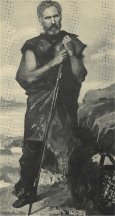 On
October 14, 1913, Joseph Knowles emerged from the forest in Massachusetts
clothed in animal skins (a foot length but sleeveless number), was greeted
and photographed, and was far healthier (according to a Harvard physician)
than when he had entered the forest two months before. On that date, his
forty-fourth birthday, August 4, Joseph Knowles had removed his clothes
and set off to live unaided in the Maine forest. Here he made fire and
a bed of leaves and branches, kept warm and healthy, engaged animals, made
use of his artistic interests by drawing on wood with the charcoaled-fire,
and survived. He reports that the difficulties in living the primitive
life were not physical, but mental. Feelings of loneliness were his major
challenge.
On
October 14, 1913, Joseph Knowles emerged from the forest in Massachusetts
clothed in animal skins (a foot length but sleeveless number), was greeted
and photographed, and was far healthier (according to a Harvard physician)
than when he had entered the forest two months before. On that date, his
forty-fourth birthday, August 4, Joseph Knowles had removed his clothes
and set off to live unaided in the Maine forest. Here he made fire and
a bed of leaves and branches, kept warm and healthy, engaged animals, made
use of his artistic interests by drawing on wood with the charcoaled-fire,
and survived. He reports that the difficulties in living the primitive
life were not physical, but mental. Feelings of loneliness were his major
challenge.
The circumstances of his return are more instructive to us than his
account of the tedious days and nights in the forest. From photographs,
we can see that his return was that of a hero. Enormous crowds packed Boston
to welcome and cheer. Would anyone today achieve such a welcome or acknowledgement
for two months in the summer forest? My bet is that Knowles was fulfilling
a dream of the time, one that touched the public consciousness about nature
and humankind’s relation to it. But the Heroes who overcame obstacles have
been replaced by celebrities.
Garner in the 1890s, to his credit, had the idea of using the newly
invented phonograph to record the vocalizations of animals, especially
primates, at the Washington Zoo with the support of the Smithsonian. From
this experience came the idea of playing the recordings to the apes and
monkeys to record and observe the animals’s reactions. Garner was well
ahead of his time in terms of scientific methodology and reasoning.
Nearly a century later, The New York Times would deem as front-page
news investigators doing exactly this, playing-back recorded sounds to
decode animal language.
Garner’s reputation was at a point, toward the end of the 1890s, that
he found funds to advance his work significantly. He proposed to go to
West Africa, to live caged, and to record the animals’s responses to him.
The notion of man (or woman) alone in the jungle in the interest of ‘science’
is a powerful one, for the image can be spotted with ease in our own times.
Garner returned from Gabon with several chimpanzees (they did not survive
the trip) and wrote several books on the adventure. The scientific results
were not thrilling, as the animals appeared to find the idea of a human
in a cage unattractive. His helper, named by him ‘Native Boy’, became bored
and left. The supply chain of bearers carrying food and necessities was
unreliable. (But someone, nameless, must have been available to take the
pictures.)
Garner’s fame was now that of an adventurer, and little attention was
paid his early, imaginative studies of ape-speech. The tales became ‘taller’,
the adventures more unbelievable, as Garner continued to write for the
next and last twenty years of his life. His books were the literary equivalent
of Rossini overtures. Each edition featured a new flourish, but sounded
familiar. He could not reply to a devastating criticism of his African
work provided by a young academic reflecting the academic and scientific
establishment having tolerated enough. For whatever reason, it would
be almost a century before scientists returned to the question of animal
speech and the technique of playing-back animal sounds. Celebrity-status
is an unhealthy mistress for some.
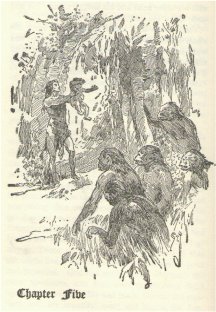 As
Garner appears to have made little if any attempt to understand the people
who populated the area he was in ---- after all, his mission was to converse
with the animals ---- we are none the wiser about the ease of learning
a new culture. Garner was, however, in the geographic area generally believed
to describe Tarzan’s upbringing. The idea of learning the culture and language
was in the air, seemingly part of the ethos of both popular and scientific
culture in the decades surrounding the turn into the 20th century.
As
Garner appears to have made little if any attempt to understand the people
who populated the area he was in ---- after all, his mission was to converse
with the animals ---- we are none the wiser about the ease of learning
a new culture. Garner was, however, in the geographic area generally believed
to describe Tarzan’s upbringing. The idea of learning the culture and language
was in the air, seemingly part of the ethos of both popular and scientific
culture in the decades surrounding the turn into the 20th century.
How much of Knowles and Garner’s reports were fiction, intentional or
otherwise? The tales, even if embellished, are believable, if just-so.
Shall we put these books on our shelf labeled fiction or labeled nonfiction?
One arbiter is the United States Library of Congress who decides the appropriate
call number for books. Richard Garner’s work is listed under “zoology:
primates, general; Joseph Knowles’ under "wildlife-related recreation,
hunting, camping, outdoor-life, and Maine." Both are nonfiction.
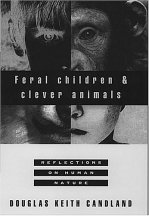 What
is Fiction? Truth? Legend? It is time that we readers were allowed to visit
the hatchery prepared for us, the result of inspired collecting, impressive
detective-work, and careful editing, in which the theme of abandonment
(whatever the reason) is joined with the archetypal narrative of facing
an alien culture (or, alternately, being born into an alien culture and
facing, in time, another culture. And that is precisely the opportunity
that our editor and compiler has planned for us. People and libraries of
now and the future are indebted and thankful.
What
is Fiction? Truth? Legend? It is time that we readers were allowed to visit
the hatchery prepared for us, the result of inspired collecting, impressive
detective-work, and careful editing, in which the theme of abandonment
(whatever the reason) is joined with the archetypal narrative of facing
an alien culture (or, alternately, being born into an alien culture and
facing, in time, another culture. And that is precisely the opportunity
that our editor and compiler has planned for us. People and libraries of
now and the future are indebted and thankful.
But, 'Fact, Fiction, or Legend '--- the hatchery cares not which it
warms and sends forth. Tarzan and his fellow illustrate to us our uncertainty
of the role of environment on species circumscribed by genes. That the
relationship poses for us the most tangled of the mysteries of human intellectual
wanderings is the basis of our longstanding, never-ending, and uncritical,
in the literary sense, interest in what it would be like to be alien to
our culture. Tarzan and his fellows are hypotheses that we know not how
to test. That is their secret, their charm, and their continuing power.
©Douglas K. Candland, 2007, All rights
reserved

 When,
in the mid-eighteenth century, Linnaeus was setting out the method of nomenclature
that we use yet today to identify animals by genera and species, he was
puzzled by the variety of human beings. There were, it was reported, people
with tails (Homo caudatus), the apes collected in his employer's
garden (Homo simia), mankind who lived in the dark (troglodyte),
humankind who called siren-like (Homo marinus) --- even human children
reared by wild creatures. These he chose to characterize as members of
the species ferus.
When,
in the mid-eighteenth century, Linnaeus was setting out the method of nomenclature
that we use yet today to identify animals by genera and species, he was
puzzled by the variety of human beings. There were, it was reported, people
with tails (Homo caudatus), the apes collected in his employer's
garden (Homo simia), mankind who lived in the dark (troglodyte),
humankind who called siren-like (Homo marinus) --- even human children
reared by wild creatures. These he chose to characterize as members of
the species ferus.
 We may also find
in our surviving library Itard's two volumes describing his work with Victor,
the Wild Boy of Aveyron (1800); or the Reverend Singh's attempts to discover
whether the human mind naturally knows God, his aim in capturing and rearing
in the early 1920s Amala and Kamala, known as the ‘wolf-girls’. Fact,
of course, for these people surely existed. Fiction, of course,
because the observers provided a narrative, one necessarily of their choosing:
legend, surely, for when Itard took up work with Victor, a play about a
feral child was already on the Paris stage, and Rousseau's romantic notions
of nature were in the air. Legend? A visit to any village in India
will reveal a story about local wolf-children.
We may also find
in our surviving library Itard's two volumes describing his work with Victor,
the Wild Boy of Aveyron (1800); or the Reverend Singh's attempts to discover
whether the human mind naturally knows God, his aim in capturing and rearing
in the early 1920s Amala and Kamala, known as the ‘wolf-girls’. Fact,
of course, for these people surely existed. Fiction, of course,
because the observers provided a narrative, one necessarily of their choosing:
legend, surely, for when Itard took up work with Victor, a play about a
feral child was already on the Paris stage, and Rousseau's romantic notions
of nature were in the air. Legend? A visit to any village in India
will reveal a story about local wolf-children.


 Born in 1881 (?),
captured, enslaved, or liberated; kidnapped or a willing adventurer ---
your choice --- in the Congo (but a Bushman) somewhere between 1892 and
1904, some say Ota Benga was recruited willingly to be displayed at the
Born in 1881 (?),
captured, enslaved, or liberated; kidnapped or a willing adventurer ---
your choice --- in the Congo (but a Bushman) somewhere between 1892 and
1904, some say Ota Benga was recruited willingly to be displayed at the
 One of six Eskimo
removed from Lapland by the US Admiral Peary in 1897 for transfer to New
York, at the request of a newspaper and American Museum of Natural History,
he was one of two to survive the stay within the museum. (The other, older
man, returned home within the year.) Peary referred to Eskimos as
‘animals with speech’, a curious assessment from a man who fathered two
children by an Eskimo woman. Minik was perhaps seven years-old at the onset
of his stay. Befriended by a museum administrator named (William)
Wallace and his wife, a surname Minik took along with the middle name of
Peary, Minik was reared for a time in their home where he was educated
in western ways and was a companion to their son, Willie. As a young adult,
Minik moved about, living for a time in a hotel on West 44th Street in
Manhattan, returning to Lapland, marrying, not happily, and returning
to New York. Upon his return to Lapland (Peary dropped him 800 miles from
home), Minik could no longer be understood when speaking his native dialect.
One of six Eskimo
removed from Lapland by the US Admiral Peary in 1897 for transfer to New
York, at the request of a newspaper and American Museum of Natural History,
he was one of two to survive the stay within the museum. (The other, older
man, returned home within the year.) Peary referred to Eskimos as
‘animals with speech’, a curious assessment from a man who fathered two
children by an Eskimo woman. Minik was perhaps seven years-old at the onset
of his stay. Befriended by a museum administrator named (William)
Wallace and his wife, a surname Minik took along with the middle name of
Peary, Minik was reared for a time in their home where he was educated
in western ways and was a companion to their son, Willie. As a young adult,
Minik moved about, living for a time in a hotel on West 44th Street in
Manhattan, returning to Lapland, marrying, not happily, and returning
to New York. Upon his return to Lapland (Peary dropped him 800 miles from
home), Minik could no longer be understood when speaking his native dialect.
 Ishi, a truly native
Californian, appeared in Oroville in 1911 indicating that he was the last
of his tribe. His language approximated that of another tribal language,
one understood to some degree by a Caucasian interpreter. Ishi explained
that all other members of his tribe known to him were dead, some killed
by ‘whites’. Taken to the Museum of Anthropology, then in San Francisco,
now on the Berkeley campus of the University of California, Ishi showed
the staff how to make arrows, tools, and explained something of his native
culture. The anthropologist Alfred Kroeber and his wife provided both an
introduction into civilized society and concern for Ishi. Both film and
slides remain of these activities. (Ishi had declined an offer from the
US Bureau of Indian affairs to be resettled on a reservation.) Ishi did
regular displays at the Museum, showing visitors the details of Native-American
crafts. He visited the theatre in San Francisco and later suggested to
the interpreter that the purpose of applause was to drive the people off
the stage. Alfred Kroeber’s publications and the later books by his wife,
Theodora, provide informative examples of Ishi’s reactions to society not
unlike those of Tarzan’s orientations.
Ishi, a truly native
Californian, appeared in Oroville in 1911 indicating that he was the last
of his tribe. His language approximated that of another tribal language,
one understood to some degree by a Caucasian interpreter. Ishi explained
that all other members of his tribe known to him were dead, some killed
by ‘whites’. Taken to the Museum of Anthropology, then in San Francisco,
now on the Berkeley campus of the University of California, Ishi showed
the staff how to make arrows, tools, and explained something of his native
culture. The anthropologist Alfred Kroeber and his wife provided both an
introduction into civilized society and concern for Ishi. Both film and
slides remain of these activities. (Ishi had declined an offer from the
US Bureau of Indian affairs to be resettled on a reservation.) Ishi did
regular displays at the Museum, showing visitors the details of Native-American
crafts. He visited the theatre in San Francisco and later suggested to
the interpreter that the purpose of applause was to drive the people off
the stage. Alfred Kroeber’s publications and the later books by his wife,
Theodora, provide informative examples of Ishi’s reactions to society not
unlike those of Tarzan’s orientations.

 As
Garner appears to have made little if any attempt to understand the people
who populated the area he was in ---- after all, his mission was to converse
with the animals ---- we are none the wiser about the ease of learning
a new culture. Garner was, however, in the geographic area generally believed
to describe Tarzan’s upbringing. The idea of learning the culture and language
was in the air, seemingly part of the ethos of both popular and scientific
culture in the decades surrounding the turn into the 20th century.
As
Garner appears to have made little if any attempt to understand the people
who populated the area he was in ---- after all, his mission was to converse
with the animals ---- we are none the wiser about the ease of learning
a new culture. Garner was, however, in the geographic area generally believed
to describe Tarzan’s upbringing. The idea of learning the culture and language
was in the air, seemingly part of the ethos of both popular and scientific
culture in the decades surrounding the turn into the 20th century.

